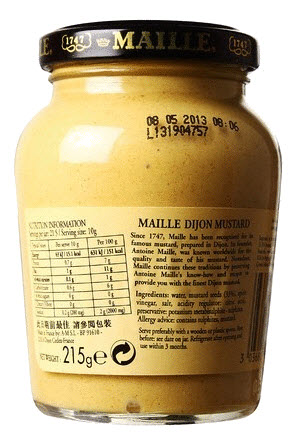- Home
- Blog
- Additives and Labels
- Additives – why do they use them?
Additives – why do they use them?
Written by Catherine Saxelby
on Friday, 28 November 2008.
Tagged: additives, allergies, artificial sweeteners, food labels, junk food, technology

Supermarket shelves today are crammed full of food products which advertise they are free of artificial colours and flavourings or contain no preservatives. The increasing claims for 'natural', 'wholesome' and 'nothing artificial' on products are testimony to the image additives have as modern-day villains in our food supply. As more and more shoppers scan the fine print, it pays to know why they're added.
How are additives shown on the label?
All additives are listed with other ingredients in the ingredient list by their class name followed by their chemical name OR their code number.
For example, citric acid may appear as either
FOOD ACID (CITRIC ACID)
or
FOOD ACID (330) - in this case, you need an additive code list to find out which food acid it is.
The numbers used in Australia correspond to an international system used to identify additives. You'll see European foods with the same additives listed with an "E" number.
The 12 key functions of additives
Different types of food additives perform many useful functions.
1. Anti-caking agents
Help foods such as salt, icing sugar mixture, sweeteners or flavour sachets flow freely when poured.
Examples:
Sodium aluminosilicate (554), magnesium carbonate (504), silicon dioxide (551).
2. Antioxidants
Prolong the life of food by slowing down oxidation which prevent fats turning rancid and food going brown.
Examples:
Vitamin E (tocopherols 306), vitamin C (ascorbic acid, 300) which keep wine and cider from discolouring. As sodium ascorbate (301), it is used in cured meats, fruit salad and vinegars.
Butylated hydroxyanisole (BHA, 320) is one of the widely used antioxidants for fats and oils as well as foods made with them such as snack foods, instant mashed potato, crisps, biscuits and muesli bars. It is often used in conjunction with a gallate like propyl gallate (310).
3. Colours
Add or restore colour to foods lost during processing which makes food more appealing and enjoyable.
Examples:
Caramel (150a), carotene (160a), tartrazine (102), Brilliant Blue FCF (133)
4. Emulsifiers
Ensure that oil and water mixtures (like salad dressings, mayonnaise, margarines, ice-creams) do not separate into layers.
Examples:
Lecithin (322), a substance occurring in soy beans and egg yolk, sorbitan monostearate (491) and mono- and di-glycerides of fatty acids (471).
5. Flavour enhancers
Improve the existing flavour and aroma of a food but contribute no flavour of their own. Often used in savoury foods ranging from cracker biscuits, gravy powders, stock powders, sauce mixes and instant noodle sachets.
Examples:
Monosodium glutamate or MSG (621), disodium guanylate (627), disodium ribonucleotides (635).
6. Food acids
Give food a sharp or sour taste which produces a pleasing flavour balance and helps maintain a constant acid level in food.
Examples:
Citric acid (330) from citrus fruit, malic acid (296) from green apples, tartaric acid (334) from grapes, acetic acid (260) from vinegar.
7. Humectants
Prevent foods such as icings, cakes, soft tortillas, dried fruit and muesli bars from drying out.
Examples:
Polydextrose (1200), sorbitol (420) mannitol (421), glycerin or glycerol (422).
8. Mineral salts
Enhance the texture of foods such as processed meats like ham, bacon or corned meat which might lose meat juices.
Examples:
Various phosphates, chlorides and carbonates eg sodium phosphate (339), calcium chloride (509), sodium carbonate (500).
9. Preservatives
Retard the growth of bacteria, yeasts and moulds, so lessening food spoilage and helping keep food safe to eat.
Examples:
Potassium sorbate (202), sodium benzoate (211), sulphur dioxide (220), calcium propionate (282), potassium nitrate (252).
10. Thickeners
Thicken foods, enhance its texture or give a smooth uniform texture to soups, custards, puddings, , pasta sauces, simmer sauces, toppings.
Examples:
Similar in function to cornflour or arrowroot used at home, they include a number of starches (1400-1405) and modified starches like acetylated distarch adipate (1422).
11. Vegetable gums
Thicken and gel foods like ice cream, desserts, dressings, sauces, toppings and mayonnaise.
Examples:
Sodium alginate (401), agar (406), pectin (440), carrageenan (407).
12. Flavours
Flavours fall into 3 groups - natural, synthetic but 'nature identical', or synthetic with no counterpart in nature. They are complex mixtures of many components, which makes them impossible to define as a single substance – hence they carry no code numbers. Many flavours have been extracted from herbs or spices or the compounds responsible for the herb's flavour have been synthesised. Foods must list the word 'FLAVOUR' on the ingredient list, even if the flavour is a natural one. Flavours make food more palatable, maintain uniformity and restore what's lost during processing.
 How to decipher the additives on the label
How to decipher the additives on the label
EXAMPLE
Take a look at this sample food label for an average Dijon mustard. Here's its theoretical ingredient list showing the 4 additives it contains as code numbers. I've written an explanation of which additives they are and why they're used:
| WATER, MUSTARD SEEDS, VINEGAR, SALT, FOOD ACID (330), EMULSIFIER (322), NATURAL COLOUR (160a), PRESERVATIVE (224). |
Food acid
330 is Citric acid - which imparts a pleasant tang and is found naturally in lemons and all citrus fruit.
Emulsifier
322 is Lecithin - which acts to keep all ingredients blended.
Colour
160a is Beta-carotene - which imparts a rich golden-yellow colour; it is converted to vitamin A in the body.
Preservative
224 is potassium metabisulphite - which helps the mustard keep well without refrigeration for over 12 months.
You may also be interested in...
The Good Stuff
The Boring Stuff
© 2024 Foodwatch Australia. All rights reserved
Author photo by Kate Williams
Website by Joomstore eCommerce










